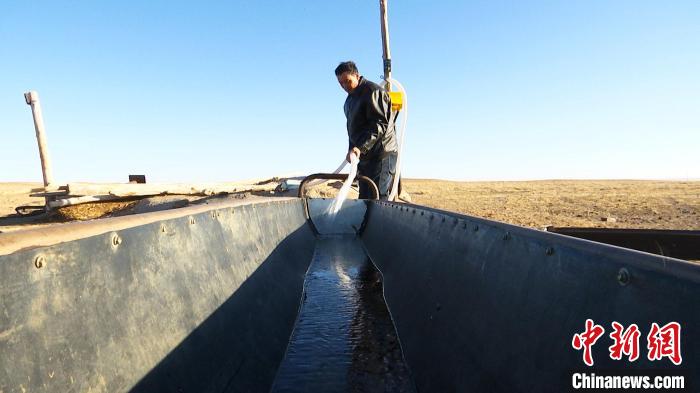Source: China News Network
Zhongxin Network Bayannaoer December 3 Title: A herdsman in Inner Mongolia "raised" 16 Mongolian wild donkeys, a national first-class protected animal
China News Network reporter Zhang Linhu
"After so many years, I have a relationship with these wild donkeys and have regarded them as part of the family." On the 3rd, Zhang Yongli, a herdsman in Bayannur City, Inner Mongolia Autonomous Region, said so.

The picture shows Zhang Yongli receiving water for a Mongolian wild donkey. Photo courtesy of Sun Chao
In the winter, the Wulat grassland was cold and windy, and Zhang Yongli filled the sink with water sharply, and then sprinkled the feed on the grassland at will, which was obviously not the food of his livestock.
Half an hour later, a group of mule-like gray-brown figures appeared at the edge of the sink. Zhang Yongli told reporters that this is a Mongolian wild donkey, a total of 16 heads.
According to the data, the Mongolian wild ass is distributed in Central Asia and West Asian countries, mainly distributed in Inner Mongolia, Gansu and Xinjiang in China, and is a first-class protected animal in China, which is listed as an endangered species by the World Conservation Union.
Zhang Yongli's home is located in Bayin Ulansumu, which belongs to the border grassland, which is the Urat Soso Forest - Mongolian Wild Donkey National Nature Reserve.
The picture shows a herd of Mongolian wild donkeys. Photo courtesy of Sun Chao
As early as 2016, Zhang Yongli accidentally discovered this group of Mongolian wild donkeys. "Since the grasslands continued to be dry and there was little precipitation, I judged that this group of Mongolian wild donkeys should have gone to the herders' homes to find water." Zhang Yongli told reporters that this group of Mongolian wild donkeys is very alert and only comes here late every night to drink water.
Months passed, and because Zhang Yongli often prepared feed and water, the group of wild donkeys took root near his home. "There were only 9 at the time, and now it has grown to 16." Zhang Yongli said.
The picture shows a group of Mongolian wild donkeys drinking water at Zhang Yongli's house. Photo courtesy of Sun Chao
Five years later, every winter when food was scarce, the wild donkeys would "go home" and "share" the Wulat grassland with Zhang Yongli's livestock.
Inner Mongolia is located in the northern Xinjiang of China, with forests, grasslands, wetlands, lakes, deserts and other natural forms, is the largest and most diverse ecological function area in northern China, and has an extremely rich comprehensive biodiversity system.
Gai Zhiyi, former dean of the College of Humanities of Inner Mongolia Agricultural University, said that biodiversity is the foundation of sustainable development and a valuable asset of nature. "Human conservation of biodiversity can not only maintain a balance in the ecological environment and ensure the sustainable development of biological populations, but also meet the needs of all aspects of human beings through the study of wild animals and plants and the rational use of biological resources." Gai Zhiyi said.
In recent years, Inner Mongolia has formulated and implemented a series of policies and measures to promote the construction of ecological civilization, carry out ecological protection and restoration, promote harmonious coexistence between man and nature, continuously improve the quality and stability of the ecosystem in the whole region, and a large number of rare wild animals such as flamingos, pan sheep, lynx, snow leopards, and original musk frequently appear in Inner Mongolia.
The reporter learned that by the end of 2020, Inner Mongolia has established 182 nature reserves of various types at all levels, with a total area of 12.6704 million hectares, accounting for 10.71% of the land area of Inner Mongolia.
The picture shows the protected area mounting a photo of a Mongolian wild donkey and giving it to Zhang Yongli. Photo courtesy of Sun Chao
In the view of Wei Zhiyong, director of the United Nations Regional Center for Sustainable Development Education hohhot, Inner Mongolia has a vast territory, spanning the "three norths", and its ecological status is extremely important, and strengthening biodiversity conservation is an important foundation for building an ecological civilization and a beautiful China.
"The conservation of biodiversity cannot rely solely on government efforts, but also requires public participation. Exploring a sustainable development path to establish harmonious coexistence between man and nature in the process of protection can provide a steady stream of impetus for the construction of this important ecological security barrier in northern China. Wei Zhiyong said. (End)